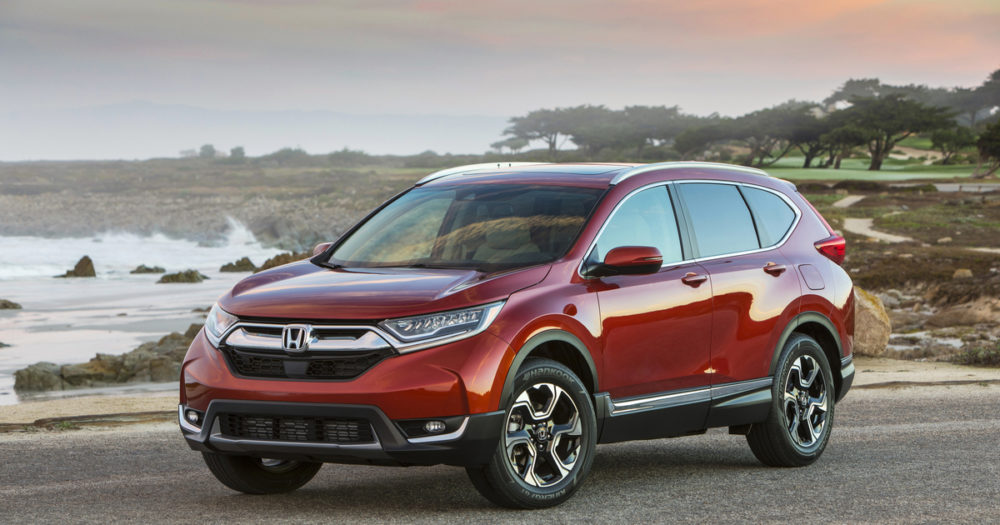Utility vehicles are all the rage these days, outselling cars nearly 2:1. So it only makes sense in our second blog in a series on how automakers can meet the 2025 standards to focus on one of the best-selling utility vehicles on the market, the Honda CR-V. While this year its sales have dipped slightly below its Toyota rival, the next generation Honda CR-V could put one of the most long-running utility vehicle nameplates back on top, in both fuel economy AND sales.
The rise of the utility vehicle means strong standards are critical
Crossover vehicles like the CR-V toe the line between car and light truck, at least as far as the regulations are concerned—two-wheel drive versions are treated like cars, and the four-wheel drive versions are classified as light trucks. As sales drop away from true passenger cars in favor of crossovers, they’re held to a lesser standard, which means increasingly more stringent requirements are the only thing standing in the way of actually moving backwards on fuel economy like the country did in the late 1990s. Rolling back those standards as the current administration proposes would be terrible as the market continues to favor the higher profit margins
Luckily for Honda, the CR-V actually shares a platform with its most popular car, the Honda Civic, which it only recently passed in sales. That means to meet stronger standards, the crossover can take advantage of many of the same technologies driving improvements elsewhere in the fleet, including the incredibly efficient 1.5L turbocharged engine shared between the Civic and the CR-V. This has led the latest CR-V to be the most efficient conventional vehicle in its class—but by 2025 it will need to do more.

Continuing to incrementally improve the CR-V would place the next generation at the top of its class in fuel economy, improving by up to 7 mpg over the current version and saving consumers thousands in the process.
On the right track
The 2019 CR-V is one of the safest automobiles on the road according to the Insurance Institute for Highway Safety—that is, in part, thanks to a significant use of high-strength and ultra high-strength steels (UHSS) in the body. However, since its debut, the CR-V has gained over 200 pounds—while the latest model has reversed that trend, shedding about 50 pounds from the previous generation, there’s still a lot more room for improvement. Increased use of UHSS and incorporating aluminum could continue to provide the same safety for Honda’s passengers, while dropping the CR-V’s curb weight to its lowest ever.
The same strategy can be applied across the board—Honda has made great strides to reduce aerodynamic drag and improve the efficiency of the electrical system in the latest CR-V, but here too there are lessons to be learned from around the industry that can continue that progress, further reducing the amount of fuel used to move the vehicle forward.
I’ve already got one of those!
The biggest change Honda could make to the next CR-V is to the baseline 2.4L engine—first released in 2013, the current “Earth Dreams” baseline engine was carried over from the previous generation CR-V and is in need of an update. The best replacement engine would take advantage of the future lighter weight CR-V and use the more efficient Atkinson cycle instead of the conventional Otto cycle—and Honda already has an engine on which to base it, a ridiculously efficient 2.0L (40% peak thermal efficiency!!!) now deployed in the Honda CR-V Hybrid in Europe. Rather than combining this engine with Honda’s impressive (and complicated) multi-motor hybrid setup as it is today, deployed in a lighter weight CR-V the engine could act as the primary propulsion source paired only with a simpler 48V stop-start system.
In addition to taking advantage of an engine already developed, Honda could also use its latest transmission to significantly improve the CR-V’s efficiency—a specially developed 10-speed automatic already available in the Honda Odyssey minivan and Acura’s RDX SUV, where it can be paired with front- and all-wheel drive, just as it would be in the CR-V.
The 1.5L turbo already in the CR-V would see a performance boost as a result of the reduced weight, but incorporating cylinder deactivation akin to the Jetta EA211 “evo” mentioned in the previous blog would help further boost fuel economy as well in the next iteration.
Honda doesn’t need to slow down progress
It’s clear from our analysis that the best thing Honda can do to meet 2025 standards in the CR-V is essentially to keep doing what it’s been doing—the company continues to improve technologies in an incremental fashion, developing solutions that can be deployed across a wide range of vehicles. This is in large part why Honda routinely ends up at the top of our Automaker Rankings.
It also helps explain why Honda pushed back more than any other major automaker on the Trump administration’s rollback and have now made a deal with California—the company is well positioned to meet the 2025 standards as they stand, thanks to continued investment in progress. If Honda actually met the standards as written instead of with the help of the paper credits they’ve pushed for, their customers would save thousands of dollars in fuel.
Improved performance and improved fuel economy could help put the CR-V back on top in sales—but at the very least, it makes an easy case for how crossover utility vehicles can meet the 2025 standards.
For more details on the analysis, check out the methodology and our blog posts about other vehicles.

